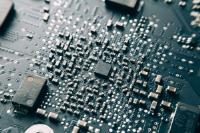 Add My Company
Add My Company
Sign In

Posted on November 2, 2015 by Ross
Cheaper and more widely available technologies like computers, mobile phones and everything in between is causing a growing ‘technology pollution’ problem worldwide.
With every electronic device requiring a chip and every chip using some type of semiconducting wafer material like silicon – the build-up of potentially harmful electronic waste is significant and growing.
Accumulating electronic waste like this is unsustainable, especially seeing as our devices seem to be getting more and more disposable (if you kept buying the latest iPhone you’d be chucking an Apple product more or less every year).
Finding an alternative material which is both eco-friendly and high-performing has been difficult.
But now, scientists in America claim that they have developed an alternative wood-based computer chip which can perform just as well as the chips that are commonly used in wireless devices.
Researchers at the University of Wisconsin, under the leadership of Zhengiang (Jack) Ma, made the electronic components just like they would with a conventional chip but then transferred them to a new surface of nanocellulose. This, they claim, reduced the amount of pollution causing semiconductor material by a factor of up to 5,000 without compromising performance.
Nanocellulose is a transparent material which is made by breaking down wood fibres on a nanoscale. Thin sheets of nanocellulose paper have previously been shown to be useful in devices like solar cells. But Ma’s research demonstrates that it has the potential to be used in high-performance radio frequency circuits too.
Using nanocellulose as the ‘supporting layer’ in computer chips could lead to a much more efficient use of semiconducting materials.
Scientists believe that the technology is ripe for commercialisation. However, Ma believes that mainstream producers will not start using the technology unless environmental pressure grows or rare semiconducting materials get significantly more expensive.
Semiconductor pollution
Although we like to think of semiconductors as clean cut, almost space age materials, they do come with an environmental and in some cases a human cost.
Environmentally speaking, semiconductor manufacturing uses a lot of water in the treatment of chemicals and materials. This can be problematic, especially in dry environments such as the famous silicon valley where water is almost a luxury good.
The chemicals themselves also have an environmental impact, not to mention the hazardous gases that manufacturing processes can produce.
On average, manufacturing just 1/8-inch of silicon wafer requires about 3,787 gallons of wastewater as well as 27 pounds of chemicals and 29 cubic feet of hazardous gases.
Semiconductor factories can also be hazardous to human health. Last year, South Korean electronics giant Samsung was forced to issue a formal apology to workers who fell ill from cancer after being exposed to toxic chemicals at the company’s semiconductor plants.
For more information on Biodegradable Chip Could Be The Answer To ‘Technology Pollution’ talk to Hi5 Electronics Ltd
Enquire Now
List your company on FindTheNeedle.
